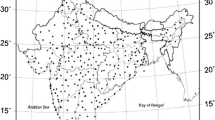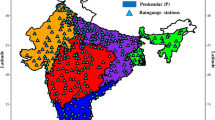Abstract
This study attempted to examine the future behaviour of monthly average rainfall and temperature of South Asian countries by using the Seasonal Autoregressive Moving Average model. Mann–Kendall trend test with Sen's Slope Estimator, to find the trending behaviour of all data series. The study has also been attempted to compare the above methods with the help of actual data. The monthly average rainfall and temperature of South Asian countries except Afghanistan and Maldives viz. Bangladesh, Bhutan, India, Nepal, Pakistan, Sri Lanka data from January, 1961 to December, 2016 have been collected from World Bank Group, Climate change knowledge portal. For estimating the trending behaviour, a non-parametric model such as the Mann–Kendall test was used with Sen's slope estimation to determine the magnitude of the trend. Box–Jenkins methodology was also used to develop the model and estimate the forecasting behaviour of rainfall and temperature in South Asian countries. Forecasting is carried out for both monthly rainfall and the average temperature of all the countries using best fitted models based on the data series. The monthly data from January, 1961 to December, 2010 are considered for validation of the model can be regarded as in-sample forecast and the data from January, 2011 to December, 2016 are used as out-sample forecast. The forecasting values with 95% confidence limit from January, 2011 to December, 2021 using best-fitted models for both rainfall and temperature. We conclude that climate change occurs for both rainfall and temperature in South Asian countries from the study period. The selected model can be used for forecasting both rainfall and temperature of respective countries from January, 2011 to December, 2021. As the climatic data analysis is valuable to understand the variation of global climatic change, this study may help for future research work on rainfall and temperature data.






Similar content being viewed by others
References
Afrifa-Yamoah E, Saeed B, Karim A (2016) Sarima modelling and forecasting of monthly rainfall in the Brong Ahafo Region of Ghana World. Environment 6:1–9
Akaike H (1974) A new look at the statistical model identification. IEEE Trans Autom control 19:716–723
Box GE, Jenkins GM (1976) Time series analysis: forecasting and control, vol 2nd. Wiley, San Francisco
Burney SA, Khan Barakzai MA, James SE (2017) Forecasting monthly maximum temperature of Karachi city using time series analysis Pakistan. J Eng Technol Sci 7:125–135
Dagum EB (2010) Time series modeling and decomposition. Statistica 70:433–457
Dickey DA, Fuller WA (1979) Distribution of the estimators for autoregressive time series with a unit root. J Am Stat Assoc 74:427–431
Dwivedi D, Kelaiya J, Sharma G (2019) Forecasting monthly rainfall using autoregressive integrated moving average model (ARIMA) and artificial neural network (ANN) model: a case study of Junagadh, Gujarat, India. J Appl Nat Sci 11:35–41
Hussain F, Nabi G, Boota MW (2015) Rainfall trend analysis by using the Mann–Kendall test & Sen’s slope estimates: a case study of district Chakwal rain gauge, barani area, northern Punjab province. Pakistan Sci Int 27:3159–3165
John AS, Brema J (2018) Rainfall trend analysis by Mann-Kendall test for Vamanapuram river basin. Kerala Int J Civ Eng Technol 9:1549–1556
Kendall M (1975) Rank correlation methods. Charles Griffin, London
Khavse R, Deshmukh R, Manikandan N, Chaudhary J, Khaushik D (2015) Statistical analysis of temperature and rainfall trend in Raipur District of Chhattisgarh. Curr World Environ 10:305
Kwiatkowski D, Phillips PC, Schmidt P, Shin Y (1992) Testing the null hypothesis of stationarity against the alternative of a unit root. J Econom 54:159–178
Lama A, Singh KN, Singh H et al (2021) Forecasting monthly rainfall of Sub-Himalayan region of India using parametric and non-parametric modelling approaches. Model Earth Syst Environ. https://doi.org/10.1007/s40808-021-01124-5
Ljung GM, Box GE (1978) On a measure of lack of fit in time series models. Biometrika 65:297–303
Mann HB (1945) Nonparametric tests against trend. Econom J Econom Soc 13:245–259
Mishra P, Matuka A, Abotaleb MSA et al (2021) Modeling and forecasting of milk production in the SAARC countries and China. Model Earth Syst Environ. https://doi.org/10.1007/s40808-021-01138-z
Nyatuame M, Agodzo SK (2018) Stochastic ARIMA model for annual rainfall and maximum temperature forecasting over Tordzie watershed in Ghana. J Water Land Dev 37:127–140
Pal AB, Khare D, Mishra P, Singh L (2017) Trend analysis of rainfall, temperature and runoff data: a case study of Rangoon watershed in Nepal. Int J Stud Res Technol Manag 5:21–38
Phillips PC, Perron P (1988) Testing for a unit root in time series regression. Biometrika 75:335–346
Radhakrishnan K, Sivaraman I, Jena SK, Sarkar S, Adhikari S (2017) A climate trend analysis of temperature and rainfall in India. Clim Change Environ Sustain 5:146–153
Ray S, Bhattacharyya B (2020) Statistical Modeling and Forecasting of ARIMA and ARIMAX models for food grains production and net availability of India. J Exp Biol Agric Sci 8:296–309. https://doi.org/10.18006/2020.8(3).296.309
Ray S, Bhattacharyya B, Pal S (2016) Statistical modeling and forecasting of food grain in effects on public distribution system: an application of ARIMA Model Indian. J Econ Dev 12:739–744
Schwarz G (1978) Estimating the dimension of a model. Ann Stat 6:461–464
Shahin MA, Huq MM, Hasan F, Ali MA, Ali AS (2016) Time series analysis, modelling and forecasting of climate variable rainfall: a case study of Rajshahi district in Bangladesh International. J Adv Res Rev 1:71–81
Yadav R, Tripathi S, Pranuthi G, Dubey S (2014) Trend analysis by Mann–Kendall test for precipitation and temperature for thirteen districts of Uttarakhand. J Agrometeorol 16:164
Yasmeen F, Hameed S (2018) Forecasting of rainfall in Pakistan via sliced functional times series (SFTS). World Environ (2018) 8:1–14
Yusof F, Kane I (2012) Modelling monthly rainfall time series using ETS state space and SARIMA models . Int J Curr Res 4:195–200
Author information
Authors and Affiliations
Corresponding author
Ethics declarations
Conflict of interest
On behalf of all authors, the corresponding author states that there is no conflict of interest.
Rights and permissions
About this article
Cite this article
Ray, S., Das, S.S., Mishra, P. et al. Time Series SARIMA Modelling and Forecasting of Monthly Rainfall and Temperature in the South Asian Countries. Earth Syst Environ 5, 531–546 (2021). https://doi.org/10.1007/s41748-021-00205-w
Received:
Accepted:
Published:
Issue Date:
DOI: https://doi.org/10.1007/s41748-021-00205-w




